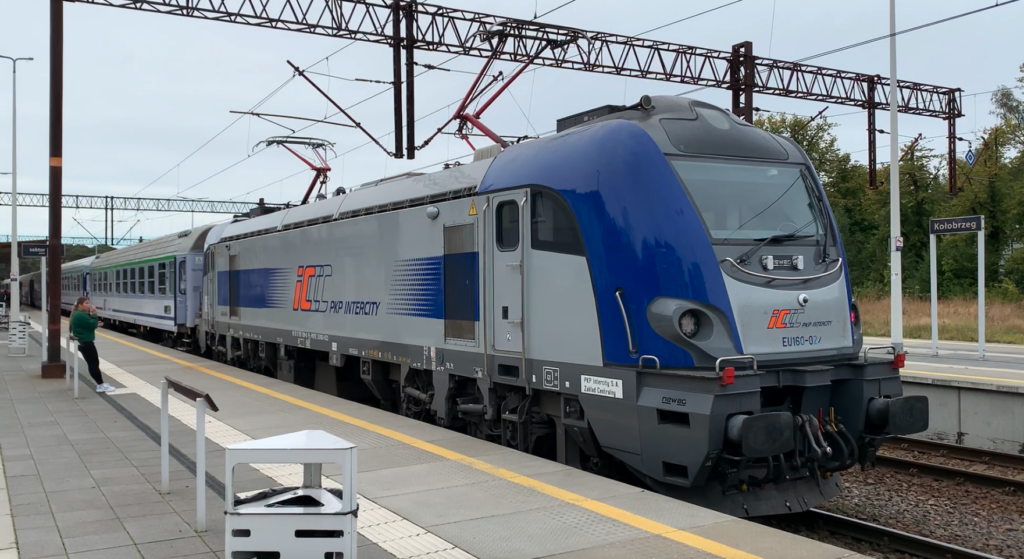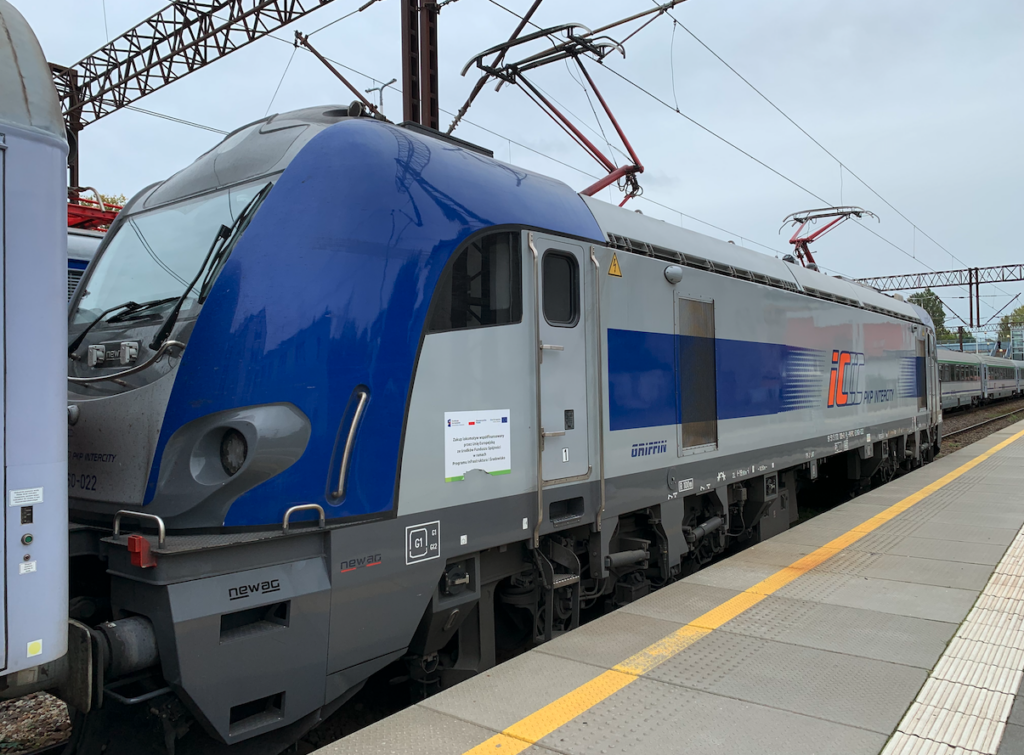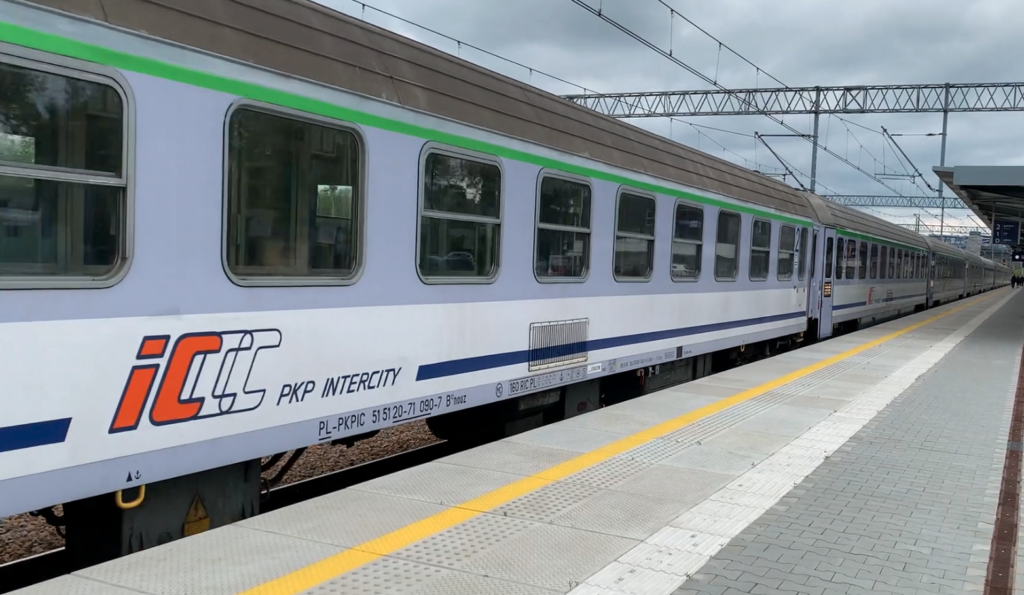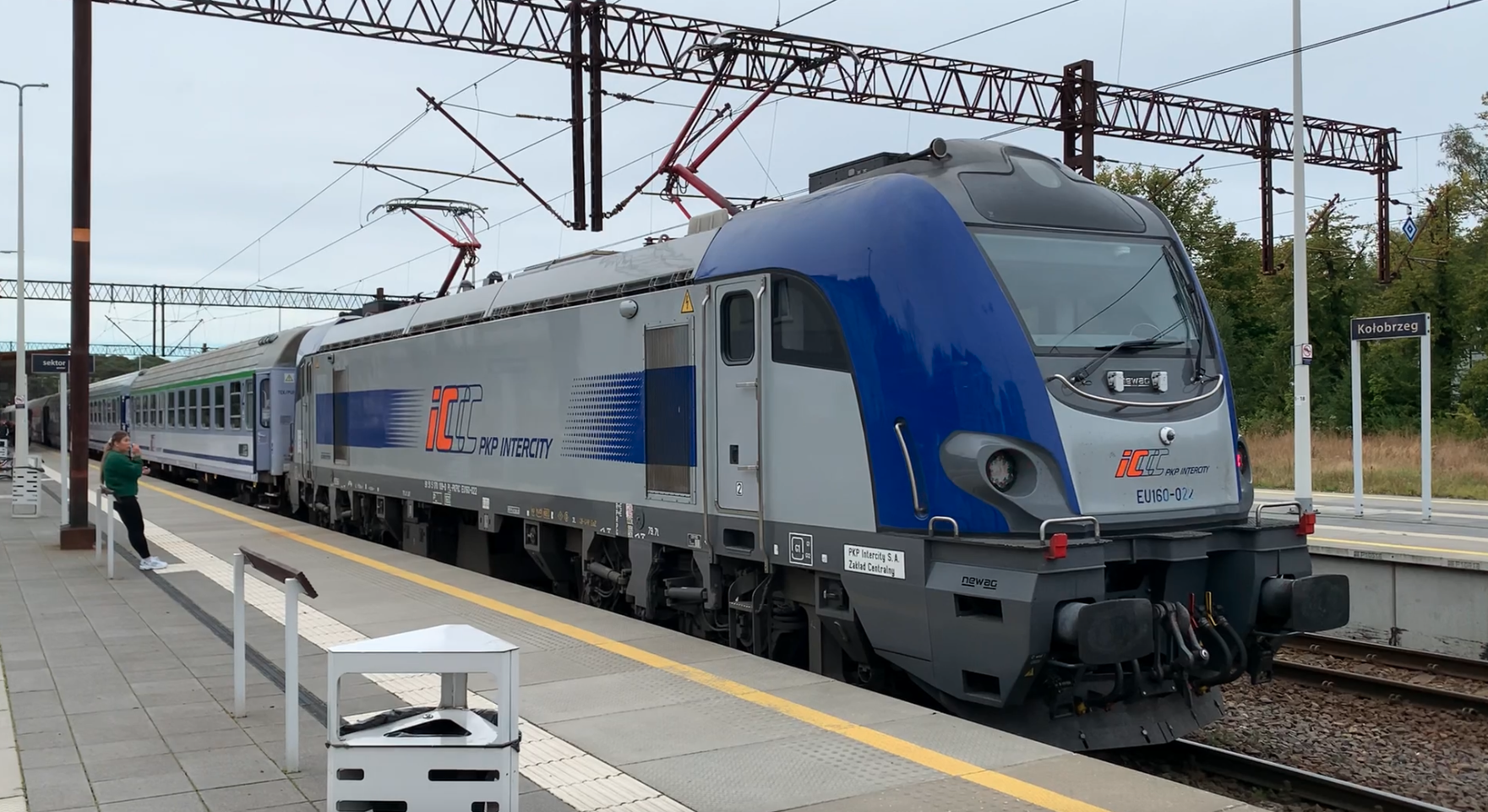Kołobrzeg 2024-11-13
InterCity train “Malczewski” Kołobrzeg – Kraków Główny.



PKP InterCity.
PKP InterCity is a Polish rail carrier that belongs to the PKP group. It deals with the transport of passengers on long routes. In Poland, it has a 15% share in passenger transport in terms of the number of passengers, but 53% in transport measured in passenger-kilometer scale. The company was established on August 30, 2001, employing 1,500 employees. Currently (2021) it employs over 8,000 employees. The company transports passengers under the Express Intercity and Express Intercity Premium brands. Under the first brand, it uses electric and diesel locomotives with classic wagons and EZT. Under the Express Intercity Premium brand, it uses 20 EZT ED250 Pendolino trains.
Initially, the competitor was the company Przewozy Regionalne, which in 2008, transferred express trains to InterCity. At that time, part of the rolling stock and employees were transferred to the InterCity company. With the introduction of the EZT ED250 Pendolino trains, the company began to make a profit. Pendolino trains are serviced at the Warszawa Grochów station.
In December 2014, after years of trials, the InterCity long-distance train category was created. These trains were strengthened by new purchases. EZT Flirt and EZT Dart were purchased, with a travel speed of 160 km/h. Electric locomotives were renovated and modernized, some of which were adapted to a travel speed of 160 km/h. Many “Y” series cars were subject to extensive renovations and modernization. The renovations also concerned restaurant and bar cars. The company also has sleeping cars and couchette cars. Since 2010, postal cars have no longer been used in Poland.
InterCity rolling stock.
Initially, InterCity did not have its own locomotives, because all of them were transferred to PKP Cargo. This turned out to be a bad solution. Therefore, the company gradually acquired new or modernized electric and diesel locomotives. In 2008, the company bought 10 multi-system Eurosprinter ES64U4 Taurus electric locomotives to service international trains.
In 2009, InterCity had the following locomotives: 1 EP05, 157 EP07s, 169 EU07s, 9 EP08s, 47 EP09s, 50 SM42s (SP42), 19 SU45s. In 2014, 10 SU160 Gama and 20 SM42-1000 Newag were purchased.
In 2020, Olkol renovated 23 electric locomotives to the EU07A standard. Among other things, electric motors were replaced with asynchronous ones. The speed of the locomotives increased from 125 km/h to 160 km/h.
In 2010, InterCity had 3,131 cars. By 2015, the company had modernized 218 cars. The renovations were carried out by Polish companies: HCP (FPS – Fabryka Pojazdów Szynowych), Pesa Bydgoszcz, Newag Nowy Sącz and ZNTK “Mińsk Mazowiecki”. By 2015, 54 new cars were purchased. In the period 2016 – 2018, another 176 cars of the series 111A, 141A, 144A, 145A were renovated.
In 2018, InterCity ordered 81 new cars from Fabryka Pojazdów Szynowych (HCP). In April 2018, InterCity ordered the renovation of 70 cars of type 111A, 112A and 140A. In 2019, a contract was signed for the renovation of another 10 cars of type 145Ab to the standard of restaurant cars. In August 2019, another 12 EZT Flirt units consisting of 8 cars were ordered from Stadler.
In 2021, InterCity had electric locomotives: 1 EP05 (speed 160 km/h), 227 EU07, EP07 (speed 125 km/h), 1 EP05 (speed 160 km/h), 23 EU07A (speed 160 km/h), 9 EP08 (speed 140 km/h), 46 EP09 (speed 160 km/h), 10 EU44 Husarz (speed 230 km/h), 30 EU160 Griffin (speed 160 km/h). 10 E4MSUa NEWAG multi-system locomotives with a maximum speed of 200 km/h were ordered for international trains. The first locomotives of this type were delivered in 2024, and were designated EU200 (maximum speed 200 km/h).
In 2021, InterCity had diesel locomotives: 17 SM42 (6D) locomotives, with a speed of 90 km/h, 10 SM42 (18D) locomotives, with a speed of 90 km/h, 17 SM42 (6D) locomotives, with a speed of 90 km/h, 10 SU42-1000 (6DI) locomotives, with a speed of 90 km/h, 10 SU160 Gama (111Db) locomotives, with a speed of 140 km/h. 10 SM42-2000 (6D-FPS) locomotives, with a speed of 90 km/h, were ordered. Of these locomotives, the best are the SU160 Gama, which have worthily replaced the SU45 and SU42-1000 locomotives, which are perfect for short passenger trains.
Currently, in 2021, InterCity has EZTs: 20 ED250 Pendolino trains, 7-carriages, with a maximum speed of 250 km/h, 32 ED160 Flirt trains, 8-carriages, with a maximum speed of 160 km/h, 20 ED161 Dart trains, 8-carriages, with a maximum speed of 160 km/h. InterCity also has 4 ED74 Bydgostia trains, 4-carriages, which for various reasons have not entered service permanently. They are currently being rebuilt and should enter service in 2022.
Passenger service.
In 2001, the carrier launched online ticket booking. Since 2005, online ticket sales have been launched. The seat was determined by a system. Then, the possibility of choosing a seat was introduced to a limited extent: by the window or by the aisle. In 2009, the carrier began selling tickets through ticket machines. In 2014, the carrier began selling tickets via mobile phones via the SkyCash mobile application. In 2015, ticket sales began at some Polish Post offices. Since 2017, online ticket sales with one transfer have been launched. Until now, tickets had to be purchased separately. Since 2021, it has been possible for passengers to choose a specific seat online.
Since 2014, the possibility of using mobile internet has been introduced on some trains and to a limited extent (access time after logging in 10 minutes). Since 2015, access to multimedia websites has been launched, among others through cooperation with the Google portal.
InterCity train 8306 “Malczewski”.
The InterCity train 8306 “Malczewski” is one of 257 typical trains. InterCity trains connect about 400 cities in Poland. The InterCity train 8306 “Malczewski” connects Kołobrzeg – Kraków Główny. In the opposite direction, the InterCity train 3806 “Malczewski” Kraków Główny – Kołobrzeg runs.
The attributes of the train are; reservation and seat selection, bar car, air conditioning (not in all cars), forced air heating, wheelchair accessible, bicycle transport, conductor deliveries, compartments for people with small children, compartment and non-compartment cars.
Route: KOŁOBRZEG 12:35, 0 km – BIAŁOGARD 13:07, 40 km – POZNAŃ GŁÓWNY 16:39 (20-minute stop), 268 km – KOŚCIAN 17:01, 317 km – LESZNO 17:17, 349 km – RAWICZ 17:33, 389 km – ŻMIGRÓD 17:43, 408 km – OBORNIKI ŚLĄSKIE 17:55, 432 km – WROCŁAW GŁÓWNY 18:33 (20-minute stop), 461 km – OPOLE GŁÓWNE 19:19, 556 km – GLIWICE 20:07, 636 km – ZABRZE 20:14, 646 km – KATOWICE 20:36 (5-minute stop), 667 km – KRAKOW GŁÓWNY 21:33, 751 km. Travel time 8 hours 58 minutes.
Here’s an explanation; During long stops, the train crew and the locomotive crew are replaced. The train does not travel on the railway line through Poznań – Piła – Szczecinek – Białogard, due to the renovation of the Szczecinek – Białogard section. Most of the route, the train travels at a speed of up to 160 km/h (Kraków – Mysłowice, Gliwice – Wrocław, Wrocław – Poznań, Poznań – Stargard). The rest of the route (Stargard – Białogard – Kołobrzeg) the train travels at a speed of up to 120 km/h. Importantly, at the Stargard station, the EU160 locomotive has to go around the train changing the front, due to the track layout in Stargard. It was not possible to designate another route, for example via Piła – Krzyż Wielkopolski, because this is a non-electrified line.
The train is very popular because it connects several important cities in the Republic of Poland. In addition, these longer stops (Poznań and Wrocław) allow for communication with other trains, such as the Berlin-Poznań train, which is often late due to the chaos on the German railways. In addition, the railwaymen working in PKP InterCity are very lenient towards passengers who have transfers to regional trains. When InterCity “Malczewski” is delayed, it is already the norm to suspend the departure of regional trains so that passengers can change. The delays of train 8306 MALCZEWSKI happened 2-4 times a month and it was never the fault of the railwaymen.
Since March 10, 2024, the train is normally headed by an EU160 locomotive. As of the schedule of September 2, 2024, the train had a mass of 455,000 kg and consisted of 9 cars, in the following configuration:
1 wagon 1st Class, No. 11, Anouz (compartment, air conditioning, 230 V sockets).
2 wagon Bar, No. 12, WRnouz (bar, air conditioning, 230 V sockets).
3rd wagon 2nd Class, No. 13, Bbnopuz (non-compartment, air conditioning, 230 V sockets, carriage adapted for transporting disabled persons, seats 11, 13 for disabled persons in wheelchairs, seats 15, 17 for carers of disabled persons, number of reservation seats 54 ([2+2] + [6×8+2, seats 21-78, 81, 83]).
4th wagon 2nd Class, No. 14, Bmnouz (compartment 10, air conditioning, 230 V sockets, Conductor’s Compartment (seats 11-16 or 101-106, seats 21-26 for persons with children up to 6 years of age, seats 91-96 for persons with disabilities, number of reservation seats 60 [10×6]).
5th wagon type 111Arow-60-12-POIiŚ, 2nd Class, No. 15, Bnopuvz (non-compartment, for transporting bicycles, air conditioning, 230 V sockets, number of reservation places 60 [(6×8 + 6) +6] places 71-78, 84, 85, 86, 87 for people transporting bicycles.
6th wagon Class 2, No. 23, Bnouz (10 compartments, air conditioning, 230 V sockets.
7th wagon Class 2, No. 24, Bnouz (10 compartments, air conditioning, 230 V sockets.
8th wagon Class 2, No. 25, B (10 compartments, without air conditioning, but with forced air heating, number of reservation places 60 [10×6], without 230 V sockets). The wagons are degraded wagons Class 1, which is why they sometimes still have a yellow (gold) upper stripe. Entrance doors of the folding type, opened manually.
9th wagon Class 2, No. 26, B (10 compartments, without air conditioning, but with forced air heating, number of reservation places 60 [10×6], without 230 V sockets). The carriages are degraded Class 1 carriages, which is why they sometimes still have a yellow (gold) upper stripe. Entrance doors of the folding type, opened manually.
Written by Karol Placha Hetman

Leave a Reply
You must be logged in to post a comment.